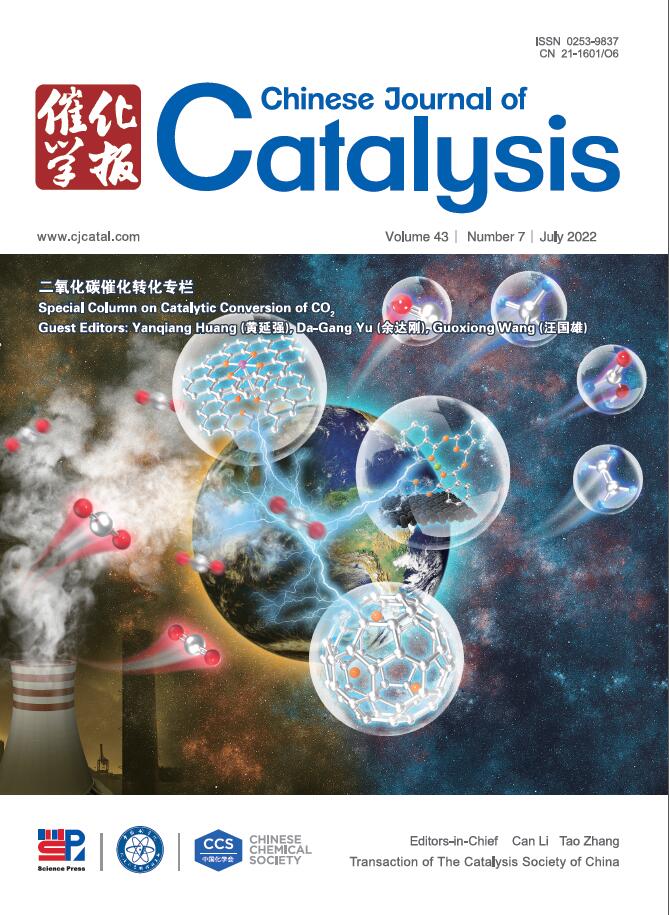Light-driven site-selective O–H activation in lignin by triplet excited alkylanthraquinone at simulated natural conditions
IF 17.7
1区 化学
Q1 CHEMISTRY, APPLIED
引用次数: 0
Abstract
Harnessing photocatalyzed hydrogen atom transfer (HAT) for the precise activation of C–H/O–H bonds is a pivotal yet challenging strategy to selectively drive oxidative C–C bond scission in renewable lignin, yielding value-added chemicals with exceptional selectivity. Herein, we present a metal-free photochemical strategy that enables selective C–C bond scission in lignin via a unique synergistic HAT pathway driven by triplet-excited 2-ethylanthraquinone (EAQ*) and hydroxyl radicals (•OH) generated in situ from EAQH2 and O2. Under simulated natural conditions, this process achieves a benzaldehyde yield of 146.6 mol% from a lignin-derived phenolic dimer. Mechanistic investigations reveal that preferential activation of the Cα-OH in lignin facilitates a tandem HAT process, forming alkoxy radical intermediates that undergo β–scission to produce benzaldehyde, as corroborated by extensive control reactions and density functional theory calculations. Furthermore, this straightforward protocol efficiently cleaves the C–C bonds of technical kraft lignins, providing a rapid, scalable, and metal-free protocol for lignin valorization under mild conditions.
模拟自然条件下三态激发烷基蒽醌光驱动O-H在木质素中的选择性活化
利用光催化氢原子转移(HAT)来精确激活C-H / O-H键是一项关键但具有挑战性的策略,可以选择性地驱动可再生木质素中氧化C-C键的断裂,从而产生具有特殊选择性的增值化学品。在此,我们提出了一种无金属光化学策略,通过一种独特的协同HAT途径,由EAQH2和O2原位产生的三重激发的2-乙基蒽醌(EAQ*)和羟基自由基(•OH)驱动,使木质素中的C-C键选择性断裂。在模拟的自然条件下,该工艺从木质素衍生的酚二聚体中获得了146.6 mol%的苯甲醛收率。机理研究表明,木质素中c - α- oh的优先活化促进了连续HAT过程,形成烷氧基自由基中间体,这些中间体经过β -裂解生成苯甲醛,这一结果得到了广泛的控制反应和密度泛函理论计算的证实。此外,这种简单的方案有效地切割了技术硫酸盐木质素的C-C键,为温和条件下木质素的增值提供了快速,可扩展和无金属的方案。
本文章由计算机程序翻译,如有差异,请以英文原文为准。
求助全文
约1分钟内获得全文
求助全文
来源期刊

Chinese Journal of Catalysis
工程技术-工程:化工
CiteScore
25.80
自引率
10.30%
发文量
235
审稿时长
1.2 months
期刊介绍:
The journal covers a broad scope, encompassing new trends in catalysis for applications in energy production, environmental protection, and the preparation of materials, petroleum chemicals, and fine chemicals. It explores the scientific foundation for preparing and activating catalysts of commercial interest, emphasizing representative models.The focus includes spectroscopic methods for structural characterization, especially in situ techniques, as well as new theoretical methods with practical impact in catalysis and catalytic reactions.The journal delves into the relationship between homogeneous and heterogeneous catalysis and includes theoretical studies on the structure and reactivity of catalysts.Additionally, contributions on photocatalysis, biocatalysis, surface science, and catalysis-related chemical kinetics are welcomed.
 求助内容:
求助内容: 应助结果提醒方式:
应助结果提醒方式:


